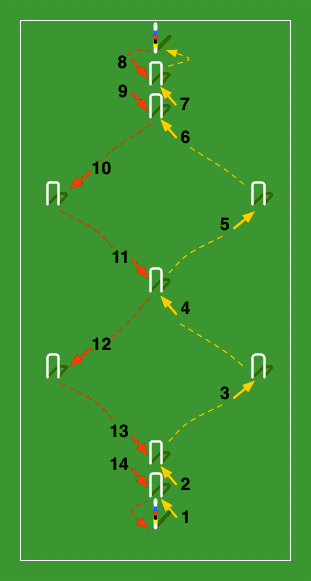
OBJECTIVE OF CROQUET: Hit your ball through the playing field to score points (up to 14 and 2) at each wicket and stake while following the course’s direction.
NUMBER OF PLAYERS: 2 players or 4 players (2 teams)
MATERIALS: Mallets, plastic balls, nine wickets, two stakes
TYPE OF GAME: Recreational Ground Billiards
AUDIENCE: Family players
INTRODUCTION TO CROQUET
Croquet is a backyard recreational sport which uses mallets and plastic balls that are hit through wickets, or hoops. It resembles other ground billiard games such as pall-mall, golf, and trucco. Derived from Latin for “ball and mallet,” the origin of the game is believed to be derived from the French game paille-maille or pall-mall. However, there are conflicting theses regarding the conception of the game.
The following is the instructions for Nine-wicket Croquet, or as it is colloquially called, Backyard Croquet.
SET-UP
Backyard Croquet does not require a freshly-mowed lawn, however, short grass is the optimal condition for gameplay. A full-size croquet court is 100 feet long and 50 feet wide, but the spacing between the wickets may be decreased proportionally if your lawn is smaller. We recommended using chalk or spray paint to mark the measurements prior to placing the wickets.
Wickets
The two stakes and nine wickets are arranged in a double-diamond pattern on the lawn. Wickets should be a standardized width and firmly implanted into the grass. Reminder, if scaling down the size of the field, the layout should remain proportional.

Balls and Mallets
In both two-player and four-player games, four balls are used. Balls typically come in black, blue, red, and yellow. Player one or team one uses black and blue; player two or team two uses red and yellow. Each player in a four-player game receives their own ball. On the occasion of a game with six players, team one plays with blue, black, and green, and team two plays with red, yellow, and orange.
Each player receives their own mallet. Mallets should be equal in length unless players mutually agree upon a different unit of measure. This is crucial because the “mallet-head” length is a common measure in the game. Typically, only the striking side of the mallet can be used to hit the ball. Players, however, may choose to modify this rule and allow side-shots.
Players often use colored clips to mark the next wicket they must shoot through. After their ball passes through the wicket, they collect their clip and mark the next one.
GAMEPLAY
The objective of Croquet is to move the ball across the course while following the proper direction through each wicket. The first player or team to score 14 wicket points and 2 stake points is the winner. However, if playing a timed game, the player or team with the greatest number of points when the time expires wins.
Order of Play
Each ball is played into the course from the halfway point of wicket one and the finishing stake. The blue ball begins, followed by red, black, and yellow. In a six-player game, the play begins the same way but culminates with green then orange. Additionally, the stake (or peg) typically displays the colors in the order of play.
A game of singles (2 players) may choose to play with one ball each for a quicker game. The winner is the first to finish the course.

Taking Shots
Players may shoot out of turn without penalty, their ball must simply be returned to its previous position. This also applies to players accidentally hitting a ball that is not their own on their turn. Swings that do not result in hitting the ball count as a shot and the turn is over unless that player has a bonus shot.
Bonus shots are earned in two ways: scoring a wicket or hitting a stake and hitting another ball with your own (“roquet”). Scoring a wicket or hitting a turning stake results in 1 bonus shot; hitting another ball results in two bonus shots. Two is the maximum number of bonus shots a striker can earn or take. When taking the first bonus shot after striking a ball, the player has four options:
- Hit the ball from the mallet-head distance away or less than where it was previously hit (“taking a mallet-head”)
- If the balls are still next to each other, the striker can hit the opponents ball out while the ball is held steady by using a foot or hand (“foot shot/hand shot”)
- Similarly to the previous position, but without using a hand or foot (“croquet shot”)
- Hit from where the striker ball stopped post-roquet
The continuation shot is the second bonus shot and is played as usual.
However, there is an exception to earning 2 bonus shots. If a player manages to score 2 wickets with a single shot, or a wicket and a stake, they earn 2 bonus shots.
If you are ‘dead’ on a ball, or without bonus hits, you must score a wicket by taking single shot(s) on your turn(s).
SCORING
Balls must pass through the wicket entirely (without rolling back) or hit the stake while moving in the proper direction in order to earn points. Passing through a wicket or hitting a stake earns a single point. Plays made out of order are not penalized.
Game Boundaries
The boundaries of the course should be established for ideal play and may be demarcated with chalk or a similar tool. If a ball is at least halfway crossing the boundary of the course, it must be placed a mallet-head length within the boundary line and perpendicular to it. Furthermore, if a ball is less than a mallet-head length away from the boundary, it too should be moved inside the boundary to a firm mallet-head length away.
Rover Balls
Once a ball has scored all the wickets, a player may choose to keep the ball in play to help advance their other ball and provide defense against the opponent’s ball(s). The rover ball may, on its turn, hit other balls and gain extra shots. However, the ball cannot earn points from wickets or stakes. Rover balls can be pushed out of the game if any player hits it against the finishing stake.
- Comprehensive Guide to the Board Game Go (weiqi, baduk) - January 23, 2024
- Are Creative Suites Changing Gaming - October 30, 2023
- How Classic Games Have Been Reimagined for Modern Audiences - October 5, 2023